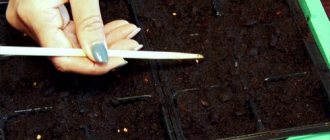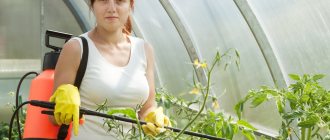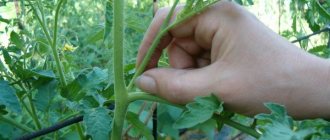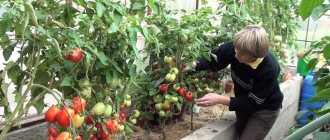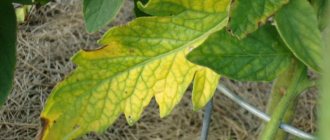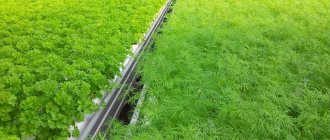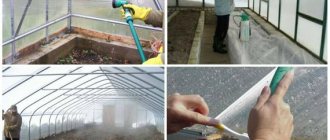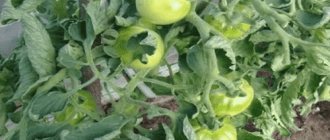The soil in greenhouses is quickly depleted, making it unsuitable for growing garden crops, especially tomatoes. The latter are quite demanding on the composition and structure of the earth. To get a high yield of tomatoes, the soil in the greenhouse must be prepared in advance, in the fall (preparation for planting tomatoes). The set of measures includes both general procedures - disinfection, cleaning of plants, and special ones - application of the necessary fertilizers, green manure, liming. The nature of the soil is of decisive importance. It is necessary to take into account the composition of the soil, acidity, and structure - heavy, light, sandy soils.
What kind of soil do tomatoes need in a greenhouse?
The greenhouse will be a good place for tomatoes. It will save the harvest from bad weather and temperature changes. But you need to take care of the soil in which they will grow. What qualities come with good soil?
- Tomatoes love warm soil full of vitamins and microelements.
- Also, these vegetables like loose and moist soil, but not swampy. You can check: if you hold the soil in your fist, a lump forms, but when pressed, it crumbles.
- Clean from roots and weed seeds.
- Disinfected substrate, disinfected from small pests.
- With an acidity level of up to 7 pH.
Preparing the soil in a greenhouse for the so-called “golden apples” takes time, so it is worth preparing the soil in advance. It is also worth considering that in previous years nothing grew in this bed that could negatively affect the tomatoes. The best predecessors would be pumpkins, beans or any root vegetables.
More information about the rules of crop rotation for vegetable crops.
Which is better to use?
The basis of any farm production is its profitability. It is from this that the manufacturer should proceed when choosing soil for the greenhouse. If it is possible to purchase inexpensive ready-made soil, of which he is confident, it is worth saving time and effort. It is recommended to use the released funds to purchase seeds of high-yielding varieties and hybrids.
If it is cheaper to purchase the components separately, then it is worth spending the time and effort to compose the soil yourself.
In any case, do not forget about mineral supplements: they will definitely be required.
Preparing a greenhouse for tomatoes in the fall
It is worth taking care of the place where tomatoes will grow in the fall - immediately after harvesting. Here are some required procedures.
- It is important to remove all crop residues, tops and weeds. This will prevent the formation of pests that cause fungal and putrefactive diseases.
- To improve the land, it is worth planting green manure. These include plants that help the earth to rest, and subsequently rot. For example, mustard, buckwheat or wheat. They should be planted before winter.
- You can also “remove” all the greenhouse soil and lay it in layers of sawdust, hay, and pine needles. Place greenhouse soil on top and cover with ash. In the spring it’s worth digging everything up. This method is suitable for preparing soil for seedlings.
Greenhouse with foundation
If you are growing tomatoes in a polycarbonate greenhouse with a foundation, where you need to form ridges and fill them with soil, then you should use the following method:
Fill the bottom of the ridge with disinfected soil, humus followed by a layer of ash. Introduce beneficial bacteria and earthworms, spill with rain or melt water and cover with film. In spring, loosen and mix all layers.
How to make beds in a greenhouse for tomatoes?
How to introduce beneficial bacteria into the soil?
First, you should purchase an ampoule with bacteria from a specialized store.
- bacteria – 1 ampoule,
- water – 2 l,
- honey - 1 tbsp. l.
Mix the contents of the ampoule with 2 liters of water, in which a tablespoon of honey is mixed.
Pour this solution into jars in equal parts. Close the jars and make a hole in the lids, then put them in a dark place.
After 3 months, the solution is ready for use.
Spill the soil with water containing bacteria at the rate of 10 grams of bacteria per 1 liter of water.
Making compost
To plant tomatoes, it is best to use homemade compost. It can be prepared during the summer using any modern biological product. For example, you can take the biological product Ekomik Urozhainy. It accelerates the maturation of compost. During the summer and autumn, waste accumulates at the summer cottage:
- tops;
- leaves;
- cut shoots;
- mown grass.
They do not need to be destroyed; they are excellent raw materials for making quick compost. Biological waste must be placed in loose piles. Water the heaps with a solution of the biological product every time a new layer 20-30 cm thick is formed.
To prepare 10 liters of solution you will need 100 ml of the drug. It takes from 1.5 to 3 months for such compost to mature. This compost can be added to the holes in the spring; it is an excellent organic fertilizer for growing tomatoes indoors. It is enough to add from 5 to 10 kg of homemade compost per square meter.
See also
How to properly grow and care for tomatoes in a greenhouseRead
After the beds are filled with compost, they are watered with a liquid solution of the biological product a week before sowing. Heat water (10 l) to a temperature of 25 °C, add 100 ml of “Ecomik Harvest” product to it. For greenhouse use, the consumption rate is 1 l/m². For disinfection, all supporting structures of the greenhouse are treated with this solution.
Preparing soil in a greenhouse for tomatoes in spring
If for some reason it was not possible to carry out the preparatory work in the fall, then you can do it in the spring.
First of all, you should definitely remove what is left from last year - weeds, crop residues or tops need to be urgently eliminated.
Then remove the top layer of soil, about 5-6 centimeters. It is in this layer that all pathogenic spores and pest larvae overwinter.
Disinfect the soil from possible pests. To do this, water the soil with a solution of potassium permanganate and copper sulfate.
How to quickly fertilize the soil
The easiest way is to sprinkle the soil with ash and humus. It is also worth digging up the soil, choosing the roots of weeds.
Freshly cut grass is another method of fertilizing the soil. The main thing is that it is mowed before flowering, otherwise it will cause future weeds. The greens need to be laid on top of the ridge and dug up.
If you plant green manure a month before planting tomatoes, then dig it up and you will get an excellent fertilizer.
How to make holes for tomatoes correctly: depth, distance
There are several ways to plant seedlings in a greenhouse. Some people plant in strict rows, so that there is half a meter between each bush, while others prefer to plant in a checkerboard pattern; here it is better to use a gap of 60 cm, especially if the varieties are spreading.
The depth of the hole is 25 cm. The width is also 25 cm. Such a hole is more convenient for planting bushes, because the seedlings need to be planted with a lump of earth around the roots of the plant. This is the best option to preserve the root system without damaging it.
Fertilizer, disinfection and tillage of soil for tomatoes
Fertilizer
You can fertilize the soil in the fall. To do this, it is worth distributing manure, ash or humus over the ridges.
If you have chickens, you can place them in a greenhouse, where tomatoes will then be planted. Chicken litter and droppings will fertilize well and warm the soil.
Disinfection
Soil disinfection is mandatory. To do this, you need not only to spill the soil with a solution of potassium permanganate (5 grams per liter), but also to carry out a set of procedures. The main enemy of “golden apples” is late blight. And therefore it is worth taking all measures to prevent it from appearing in the greenhouse.
- Mix half a teaspoon of copper sulfate with 1.5 tablespoons of quicklime and dissolve in a liter of water.
- Sprinkle the solution evenly over the bed. (It is worth considering that a liter is only enough for 1 square meter)
- The next day, sprinkle with wood ash.
Other preparatory measures
It is worth cultivating the soil for tomatoes not only by mixing various substrates, but also by preventing the germination of weeds.
Humus often stores the roots of weeds, and manure often stores the seeds of wild grasses.
To avoid the trouble of filling your beds with weeds, you don’t need to sort through the humus, choosing roots, much less look for seeds in the manure. For this purpose, there is mulching - this is a technology that prevents the germination of weeds.
For mulching, you should use bark, sawdust or straw. This procedure also prevents the evaporation of moisture necessary for tomatoes, maintains the correct level of acidity, nourishes the soil with microelements and maintains an optimal temperature level.
List of recommended tomato varieties for greenhouse cultivation
Recently, selection in the field of vegetable growing has gone far ahead and therefore a large number of excellent seeds have been developed for greenhouses:
- Aphrodite F 1;
- Berberana F1;
- Vityaz F1;
- Nadezhda F1;
- Nugget F1;
- Sylvester F1.
It should be noted that it makes no sense to collect seeds from hybrids, since their offspring do not have the qualities of their parents. In other words, the proposed varieties are used once; there is no need to collect seeds from them. The above varieties have sufficient yield and taste.
Reviews from gardeners
Experienced gardeners and gardeners recommend fertilizing the soil with potassium, calcium and using organic fertilizers and compost in equal proportions.
They also advise adding sand to the soil - they claim that it is sand that makes the soil loose and maintains the desired level of moisture.
Planting experts say that one of the rules for a good harvest is the correctly selected variety (more information about the best varieties of tomatoes for greenhouses). It is worth paying close attention to this part of preparing the future harvest.
Tomatoes must be planted on narrow ridges, 60-70 centimeters and in one row. This will ensure not only a good harvest, but also make it easier to care for the garden bed.
Some gardeners speak well of adding eggshells to the soil, claiming that it enriches the soil with calcium.
Biological method of soil restoration
The biological method of soil restoration involves the use of soil fertility biological products. The mechanism of action of these biological products is based on the ability of microorganisms, processing organic matter, to form compounds accessible to plants.
Preparing a greenhouse for planting tomato seedlings using biological products is very effective. The likelihood of contracting late blight, blossom end rot, TMV, and other fungal diseases is reduced . In soil treated with a biological product, beneficial microorganisms suppress the activity of pathogens, which contributes to better growth of tomatoes and a reduction in disease incidence. When a summer resident has a question about how to treat a greenhouse in early spring so as not to have to treat tomatoes during the summer, we can recommend proven preparations:
- Baikal;
- Baktofit;
- Trichodermin.
To restore the soil, biological products must be used for several years (3-4 years). In the spring, along with the use of drugs, the greenhouse should be filled with a new portion of organic matter. This is well-rotted manure, chicken droppings, compost. The richer the soil is in organic residues, the more microorganisms will produce useful substances.
Gardening Tips and Tricks
All foliar feeding in protected soil conditions should be carried out only in the evening or on cloudy days. This way the plants will be saved from sunburn. You should not overuse sheet processing. You need to fertilize when the roots are not able to get enough nutrition on their own.
It is interesting that the tomato itself informs the gardener about the lack of certain elements. For example, with a lack of manganese, uneven yellow spots appear on the leaves. With iron deficiency, the foliage begins to turn yellow from the base and gradually becomes white with green veins. If the tip of a young leaf becomes bent and the old foliage darkens, this is a sign of calcium deficiency. When small leaves form on the bush, spots appear on them that look like burns - the tomatoes ask to feed them with zinc.
Extraordinary feeding
Sometimes tomatoes signal a deficiency of some element by characteristic changes in appearance.
By looking closely at the plants, you can understand what fertilizers they need:
- With a lack of nitrogen, growth slows or stops. The lower leaves begin to turn yellow, and the upper young leaves become faded in color. To correct the situation, tomatoes are fed with urea, using 25-30 g of the substance per 10 liters of water or a solution of ammonium nitrate prepared in the same proportion. However, it must be remembered that excess nitrogen fertilizers lead to the accumulation of nitrates in fruits.
- Phosphorus deficiency is manifested by the fact that the underside of the leaves acquires a bluish tint. A solution of superphosphate (30 g per 10 liters of water) will help fill the deficiency of the element. Yes, the preparation of the composition uses boiling water, the fertilizer should infuse for 10-12 hours. For young bushes, apply 0.5 liters of solution; for adult specimens, the dose of fertilizer is doubled. Tomatoes that receive enough phosphorus are less susceptible to diseases.
- Potassium deficiency manifests itself by curling of the upper leaves and the appearance of a brown border on them. In this case, the tomatoes are sprayed with potassium sulphide at the rate of 15 g of the substance per 10 liters of water. If there is a deficiency of potassium, the root system of tomatoes will be weak, and the fruits will not be large enough.
- Lack of iron is expressed by the appearance of chlorosis. The main tissue of the leaf blades turns pale, bright green veins stand out against its background. Iron chelate will help eliminate the deficiency of the element. A solution is prepared from 5 g of the drug per 5 liters of water.
- A lack of calcium is indicated by the fact that the shoots grow thin and overly elongated. Plants can be saturated with this element using calcium nitrate. Consumption - 30 g of the drug per 10 liters of water.
If you apply foliar fertilizing, the results will be noticeable faster. The concentration of fertilizers when sprayed on the leaf is halved.
Soil value
When growing tomatoes, you need to take into account that the roots of this crop are highly branched and have a superficial location. From the top soil layer, plants take the maximum amount of moisture and minerals necessary for full development.
Taking this into account, soil is selected for planting tomatoes:
- moisture-absorbing and water-permeable;
- soft and crumbly;
- rich in nutrients;
- heat-intensive and heat-permeable.
If the substrate does not meet the above characteristics, then you should not count on high yields.
You can tell if tomatoes like the soil by their appearance:
- If the soil is poor in nitrogen, the stems look frail and thin. The leaf blades do not reach normal size and have a pale green color.
- With phosphorus deficiency, tomatoes grow slowly. The leaves take on a burgundy, almost purple color.
- If there is a lack of potassium in the soil, the edges of the leaf blades have a brownish color.
- With calcium deficiency, tomatoes do not grow, the upper parts of the shoots darken and rot. Few fruits are produced.
What to feed to make them plump
Why do gardeners hope that as they grow, tomato bushes will become strong and plump? Yes, because such plants give a more generous harvest. Thick stems provide adequate nutrition to the fruits and do not break off under the weight of ripe vegetables. The aspirations of gardeners are not always justified in themselves. Tomatoes often need to be helped by feeding.
See also: How to properly care for tomatoes in open ground after planting
If you also encounter this problem, try one of the recipes below:
- You need to mix 500 g of chicken manure, 500 g of wood ash, 1 glass of sugar, 10 g of dry yeast and pour the ingredients into 10 liters of water. Before use, the mixture must be properly fermented.
- Tomatoes must be fed in a timely manner to avoid thinning of the stems. The bushes will be strong if they are fed with calcium nitrate or urea in the early stages of growth, using 30 grams of fertilizer per 10 liters of water.
- You can give tomatoes a large dose of potassium using banana peel tincture. The peels of 4 bananas are placed in a three-liter jar and filled with warm water. The fertilizer should infuse for 3 days in a dark, cool place. After this period, fertilizing is used for watering at the root to strengthen the stems.
It is necessary to monitor the condition of the plants even at the seedling stage, because it is at this time that the tomatoes begin to stretch. In addition to self-prepared fertilizers, you can use industrial preparations, for example, “Athlete” or “Stop Growth”. Both products promote enhanced root growth while simultaneously stopping the growth of the vegetative part.
The growth stimulator “Etamon” has proven itself well when growing tomato seedlings. After using it, the bushes become lush, beautiful, strong, and develop roots well.
To prevent seedlings from stretching out due to a lack of important microelements, they are fed 2 weeks after picking with one of the complex mineral fertilizers:
- "Agricola";
- "Baby";
- "Strong";
- "Emerald";
- "Fertika Lux";
- "Ideal";
- "Solution";
- "Ferovit".
After another 2 weeks, fertilizing is repeated.
If you did everything correctly at this stage, then by the time you transplant them into the ground, the tomato bushes will be strong and healthy, with thick stems and emerald leaves.
Plant care
Half a month after planting, the bushes must be tied to a trellis. The temperature in the greenhouse is maintained at 18-30 degrees. WITH.
Although tomatoes are self-pollinating plants, for better pollination they can be helped: in sunny weather, shake the brushes. Immediately after this, the soil is watered or the flowers are sprayed, and after 2 hours the greenhouse is ventilated.
For proper formation of the plant, it is necessary to remove the stepsons until they reach a length of 5 cm. If larger stepsons are removed, the tomatoes will experience stress. When fruits appear, all leaves below the inflorescence are removed from the stems. It is better to remove leaves and shoots in clear, warm weather, so the wounds heal faster.
What complex fertilizers can be added?
In addition to simple fertilizers, complex mixtures can be added to the holes under tomatoes: ammophos, nitroammophos, nitrophos, which immediately contain both nitrogen and phosphorus. It is also permissible to use complexes enriched with chemical elements necessary for plants, and not just nitrogen, phosphorus and potassium. From these, tomatoes receive not only basic nutrition, but also microelements.
When planting tomato seedlings, you can use:
- Kemiru station wagon;
- Mortar;
- Crystallon, etc.
Solutions are prepared according to instructions. It is beneficial to use complex fertilizers throughout the growing season of tomatoes, and not just during planting: you just need to dilute them with water in the recommended proportion, you do not need to mix any additional fertilizers, make calculations, or water the bushes with different fertilizers several times.
It is important to remember about dosages and that all fertilizers, both organic and chemical, must always be thoroughly mixed with the soil, and not just poured into a hole and placed on top of tomatoes, otherwise the roots of the transplanted plants may burn. After planting, all tomatoes need to be watered, covered with soil, compacted, and covered with a layer of peat or other mulch.
Spring activities
They start by warming up the earth.
Warm up in several ways:
- They loosen and prepare the soil for planting, cover it with black film until planting.
- They loosen, dig grooves, water with hot water, bury and cover with film for 2-3 days.
They make warm beds. Remove a 25-40 cm layer of earth. Place bark and sawdust on the bottom of the groove. The top is covered with hay or straw and watered with quicklime. Put the soil back, mixing in compost or rotted manure.
To prepare the soil, perform the following procedures::
- Pre-loosened.
- Warm up the soil.
- Fertilize with organic fertilizers.
- Neutralizes acidity.
- They dig, loosen deeply and level the soil.
- Water with biological solutions.
How to treat greenhouses before planting vegetables
Immediately before planting, it is necessary to treat the greenhouse. This is necessary to prevent the development of fungal and other diseases, as well as the appearance of pests. For processing, you can use special preparations, sulfur, and laundry soap.
During the treatment, the entire greenhouse structure and covering material are cleaned . The soil is also treated with various solutions. They are bred according to the instructions on the package and applied to the ground.
If you follow all the above rules, you can properly prepare the greenhouse for growing tomatoes. And with proper preparation, you will receive a high-quality and rich harvest, which your whole family will enjoy.
Homemade mixtures
If it is not possible to use purchased mixtures, you can prepare the soil for the greenhouse yourself.
In the fall, after harvesting, you should remove the remaining greenery and carefully dig up the soil, freeing it from the roots of previous plants. The prepared soil needs to be checked for moisture: make a lump, and if it crumbles, then everything is in order. The soil made for the greenhouse should smell like earth (without third-party odors).
Benefits of homemade soil:
- You can prepare it according to the exact recipe and maintain the exact amount of microelements you need.
- Saving money.
Flaws:
- Long cooking time.
- You need to follow the recipe exactly.
- The soil may be contaminated.
- Finding and purchasing the right sweeping components can take a lot of time and money.
We invite you to watch a video on how to prepare soil for a greenhouse with your own hands:



